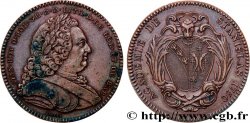fjt_713619 - LORRAINE - DUCHY OF LORRAINE - FRANCIS III François de Lorraine et d'Anne d'Este n.d.
Not available.
Item sold on our e-shop (2021)
Price : 15.00 €
Item sold on our e-shop (2021)
Price : 15.00 €
Type : François de Lorraine et d'Anne d'Este
Date: n.d.
Metal : brass
Diameter : 29 mm
Orientation dies : 3 h.
Weight : 4,44 g.
Edge : lisse
Rarity : R1
Catalogue references :
Predigree :
Exemplaire provenant de la Collection MARINECHE
Obverse
Obverse legend : FRAN. DE. LORRAINE. D. D. GUYSE. P. GR. CH. DE. FRANCE.
Obverse description : Armes parties de François de Lorraine et d'Anne d'Este.
Reverse
Reverse legend : ANNE. DE. ESTE. DVCHESSE. DE. GVYSE.
Reverse description : Monogramme Phi et Alpha.
Commentary
Anne d’Este, connue aussi sous le nom de Anna d’Este, est née le 16 novembre 1531 à Ferrare, et morte le 17 mai 1607 à Paris. Elle était la fille aînée d’Hercule II d'Este, duc de Ferrare, et de Renée de France. Duchesse d’Aumale, puis de Guise, par son premier mariage, elle devint en secondes noces duchesse de Nemours et de Genevois. Petite-fille du roi Louis XII et d'Anne de Bretagne, elle fut une figure importante de la cour de France pendant les guerres de religion et y exerça une influence considérable. Elle poursuivit notamment en justice l'amiral de Coligny qu'elle jugeait responsable de l'assassinat de son premier mari. Et après l'assassinat de ses deux fils par le roi Henri III, elle adhéra activement à la Ligue.
Pour son portrait et le reste de sa biographie, voir http://fr.wikipedia.org/wiki/Anne_d%27Este
François Ier de Lorraine, (17 février 1519, Bar-le-Duc - 24 février 1563, Cernay, Saint-Pryvé-Saint-Mesmin ou Saint-Hilaire-Saint-Mesmin), 2e duc de Guise (1520-1563), comte, puis duc d'Aumale et pair de France, Marquis de Mayenne, baron, puis prince de Joinville, grand chambellan, grand veneur, et grand maître en 1559.
Compagnon d’enfance du roi Henri II, François de Guise est un chef militaire de renom, à la tête d’un puissant lignage. Il dirige la France sous le règne de François II, de 1559 à 1560 et s’illustre comme le chef des catholiques durant les guerres de religion. Il meurt assassiné par un réformé, le 18 février 1563.
Pour sa biographie et son portrait voir http://fr.wikipedia.org/wiki/Fran%C3%A7ois_de_Guise .
Pour son portrait et le reste de sa biographie, voir http://fr.wikipedia.org/wiki/Anne_d%27Este
François Ier de Lorraine, (17 février 1519, Bar-le-Duc - 24 février 1563, Cernay, Saint-Pryvé-Saint-Mesmin ou Saint-Hilaire-Saint-Mesmin), 2e duc de Guise (1520-1563), comte, puis duc d'Aumale et pair de France, Marquis de Mayenne, baron, puis prince de Joinville, grand chambellan, grand veneur, et grand maître en 1559.
Compagnon d’enfance du roi Henri II, François de Guise est un chef militaire de renom, à la tête d’un puissant lignage. Il dirige la France sous le règne de François II, de 1559 à 1560 et s’illustre comme le chef des catholiques durant les guerres de religion. Il meurt assassiné par un réformé, le 18 février 1563.
Pour sa biographie et son portrait voir http://fr.wikipedia.org/wiki/Fran%C3%A7ois_de_Guise .








 Report a mistake
Report a mistake Print the page
Print the page Share my selection
Share my selection Ask a question
Ask a question Consign / sell
Consign / sell
 Full data
Full data